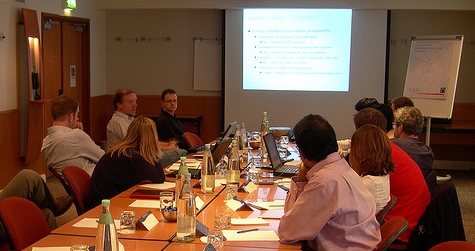Safety committees are an excellent way to improve safety in any organization. When implemented correctly, they take advantage of the collective knowledge of the entire company—particularly the front-line workers who most directly affect safety.
Safety committees may be legally required at your company, depending on its size, industry, and location. But even if they aren’t, they are smart business because—in addition to keeping personnel safer— they can reduce safety-related costs.
Here are 10 tips for how to set up safety committees that are truly effective at improving safety.
1. Secure upper management support. Without this support, safety committees will never be as effective as they should be. If a safety committee makes a recommendation (to use safety inspection checklists, for example), and upper management provides no action, or even feedback, then what’s the point? Before forming a safety committee, the company’s top leaders must be ready to clearly communicate with the committee and demonstrate through actions that they value its input.
2. Have more front-line personnel involved than managers. Front-line experience is essential to identify the real-world safety hazards. Including a higher proportion of front-line personnel on the committee also sends the message that the company is serious about safety. If you’re genuinely concerned about safety, how can you not place the most value on the insights of the people whose health is at risk?
3. Include as many people as possible. To avoid committees that are so large that you can’t get things done, form subcommittees to allow more participation. The benefits are a larger pool of knowledge, more in-depth focus, and greater buy-in to the importance of safety (participation drives personal investment). Every committee or subcommittee member essentially becomes an ambassador for safety.
4. Have all departments and shifts represented. Having all areas represented is necessary to fully address all safety issues within the company. Also, no area of the company should feel like it’s being excluded from the safety effort; otherwise personnel in that area are likely to resist (or at the least be apathetic) about safety initiatives proposed by the committee.
5. Strategically use your subcommittees. Maintain a centralized committee to coordinate each subcommittee’s efforts so there’s no duplication. Give each subcommittee a specific focus (e.g., facilities safety, equipment safety, employee health).
6. Don’t let safety professionals (or anyone else) dominate committee meetings. The most-valuable feedback comes when everyone is given an opportunity to steer the discussion toward issues they consider important. Safety professionals should take a “facilitator” role rather than a leader role.
7. Establish meeting rules and structure. While open discussion should be encouraged, it can of course get out of hand. No one wants shouting matches or people talking over each other. Set ground rules for the length of meetings, how committee leaders are selected, how speakers will be recognized, etc.
8. Keep your committees fresh. Routinely bring new blood into committees to allow for diverse perspectives and to benefit from the enthusiasm newcomers often bring. Another way to keep up excitement is to rotate the focus of the subcommittees, giving them opportunities to tackle different issues.
9. Look at how other companies (particularly companies similar to yours) are using safety committees. Peer advice can be very valuable, and companies are usually proud to share safety strategies that have worked—including how they’ve implemented safety committees. You may even be able to get representatives from another company’s safety committee to come speak at one of your committee meetings.
10. Make specific proposals. Don’t forget the purpose of safety committees—to come up with actionable proposals to improve safety. Task each committee with developing actual, detailed proposals to improve safety (e.g., increasing the amount of safety training new employees receive, investing in safety equipment, requiring the use of equipment inspection checklists such as The Checker).
Takeaway
Safety committees can provide substantial value to businesses by leading a company-wide effort to improve safety. If your company follows these tips in setting up its safety committee, it’s well on its way to making real changes that improve safety and the bottom line!
Image courtesy of Lars Plougmann, Creative Commons.











